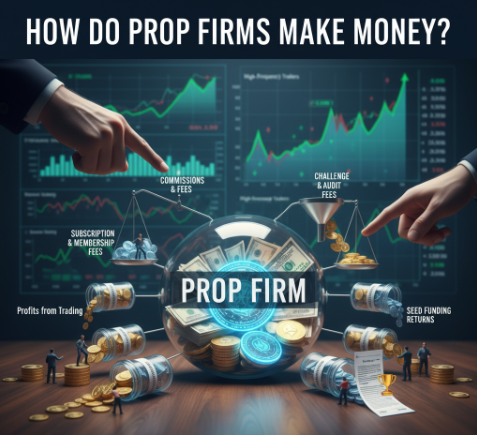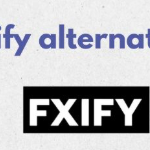In this article, I will cover how prop Firms Make Money. Prop firms are businesses that trade financial markets using their own funds and give traders funded accounts.
- Understanding Prop Firms
- How Do Prop Firms Make Money
- Profit Sharing from Traders
- Evaluation and Subscription Fees
- Proprietary Trading
- Educational Programs and Mentorship
- Risk Management Policies
- Factors That Affect Prop Firm Profitability
- Do Prop Firms Use Real Money?
- The Challenge Model
- Risk Management and Profit Protection
- Maximum Drawdown Limits
- Trade Volume Restrictions
- Stop Loss Orders
- Frequent Supervision
- Strategies for Managing Drawdown Risk
- Conclusion
- FAQ
Through profit sharing, evaluation fees, prop trading, and educational offers, they manage to lose only a minimal amount and maintain a tight risk management strategy to shield their funds while generating a profit in any market.
Understanding Prop Firms
Proprietary trading firms and prop firms deal with trading on their own capital and not on their clients funds. Like any prop firm, they also hire traders and give them fully funded trading accounts so they can trade stocks, forex, crypto or commodities on behalf of the firm.

Sponsored traders make passive income by working on behalf of the firm. Both the trader and the prop firm set their own periodic income goals.
Prop firms have risk management, advanced trading algorithms, and other proprietary tools and techniques to help increase the profit while also reducing the risk which makes the relationship profitable for both the trader and the firm.
How Do Prop Firms Make Money

Profit Sharing from Traders
- They make money from traders by providing capital wherein traders make profits, and traders make profits by paying 20% to 30% to the prop firm.
Evaluation and Subscription Fees
- Some prop firms evaluate traders and charge them for accounts, platform fees, and for other educational materials.
Proprietary Trading
- These firms trade for themselves, earning from direct market profits, spreads, and arbitrage.
Educational Programs and Mentorship
- They offer materials and lessons, and charge to add new income sources.
Risk Management Policies
- Ensuring that predicted losses minimize the firm’s capital and fees.
Factors That Affect Prop Firm Profitability
Trader Skill Levels: Every trader possesses a unique mix of skills and tactics, which collectively determine the profit earned by the firm through profit sharing.
Market Conditions: Various market characteristics, including volatility, liquidity, and market trends, all influence the profit earned or the outcome of trades.
Fee Structures: The revenues earned by the firm are determined by the profit splits, evaluation fees and the subscription costs.
Risk Management Practices: Proper monitoring, position sizing, and adequate stop-loss limits minimize losses and protect capital.
Trading Tools and Technology: Increased possible profits are gained through the use of advanced platforms and analytics, which improve the efficiency of the trades.
Number of Active Traders: Increased revenues of the firm is gained from more skilled traders managing the funded accounts.
Do Prop Firms Use Real Money?
Yes, proprietary firms definitely use real money. It, however, depends on the type of trading being done. When a trader is funded, the capital with which the trader trades is supplied by the firm, not by the trader themselves.
This means the trader can trade stocks, forex, crypto, or even commodities without putting his money at risk. It is worth noting that firms closely monitor the trades that are conducted.
They have specific risk management policies to monitor the firm’s capital, which means that controlled losses are allowed. Profits, on the other hand, are shared between the firm and the trader, while the firm absorbs losses.
The Challenge Model
Evaluation Phase
Participants must register and pay to participate in a simulation that tests their trading competencies.
Profit Targets
Participants must achieve specific amounts within a specified time period to be eligible for funding.
Risk Management Rules
Daily loss limits, maximum drawdowns, and position size limits are set and need to be followed.
Scaling Opportunities
Funded accounts and profit splits are escalated for traders who achieve the set targets.
Fee-Based Revenue
The firm collects challenge fees from the participants, regardless of the outcome of their attempt to complete the challenge.
Risk Management and Profit Protection
Maximum Drawdown Limits
Traders must adhere to maximum daily and total loss rules to avoid entering an untenable financial situation.
Trade Volume Restrictions
Limits to the amount of capital allocated to a trade mean the firm’s risk in the market can be controlled.
Stop Loss Orders
Pre-set loss levels help avoid catastrophic losses for the trader, and also loss of reputation for the company.
Frequent Supervision
Accounts are alarmed in case an account behaves exceptionally, helping in the instant assessment of account and trader metrics.
Strategies for Managing Drawdown Risk
A significant risk reduction is achieved by protecting profits through hedging.
Conclusion
Prop firms generate revenue through multiple streams, including the monetization of managed trading skills, evaluation fee collections, proprietary trading, and educational programs.
To protect their investment and earn a stable income, prop firms shield their capital by providing risk-averse traders with funded accounts. Earning revenue depends on the quality of talent and trading tools matched, as well as the overall mark.
The situation. Overall, prop firms successfully manage the risk versus reward dilemma, enjoying system profits while traders also benefit from market prospects.
FAQ
Do traders risk their own money?
Usually, no. Traders utilize the firm’s capital, but they must adhere to strict risk management guidelines.
How do prop firms earn revenue?
They earn through profit sharing with traders, evaluation or subscription fees, proprietary trading, and educational programs.
What is a prop firm?
A prop firm is a company that trades financial markets using its own capital, providing traders with funded accounts to execute trades while sharing profits.
Can prop firms lose money?
Yes, but risk management policies like drawdown limits, position sizing, and stop-loss rules minimize potential losses.







